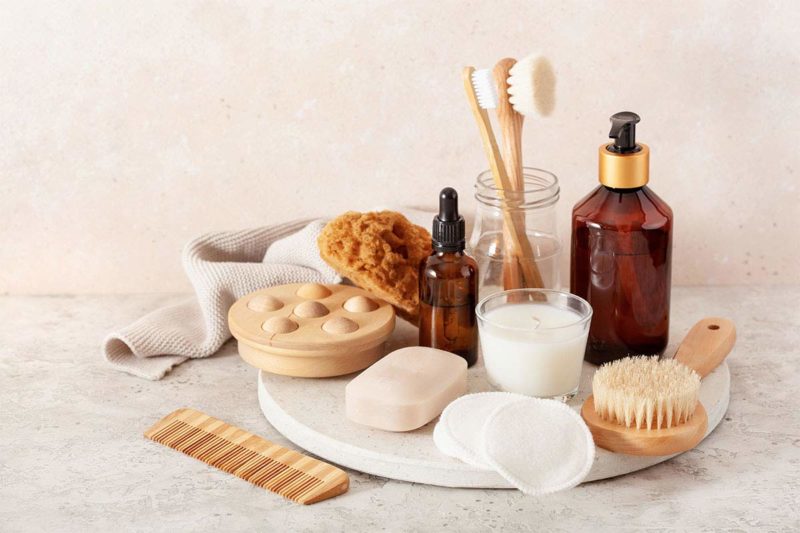The beauty universe is changing… For the better. After having gone for the convenience of single-use products, it is once again extolling the virtues of accessories that are sustainable and re-useable, endlessly or almost endlessly. But are these new tools really eco-friendly?
Sustainable beauty tools – good news?
Those who have been into ecology since the early days are well acquainted with zero-waste beauty. As well as the use of solid shampoo, toothpaste and deodorant, and soap instead of shower gel, clean beauty is also about sustainable accessories. Like a hairbrush or any other product, these items are made via production processes that are respectful of the environment to a greater or lesser extent, and use up resources and materials. But the re-useable nature of these beauty tools does not in itself make them clean. It is difficult to ascertain whether the sustainable version of a beauty routine using an accessory is more virtuous than the equivalent in product form. Is a cleansing brush more eco-friendly than cleansing gel that does the same thing? You’ve got to take a closer look at it.
This applies all the more since the success of a new tool can bring with it its share of cut-price ranges and less than scrupulous manufacturers wanting to ride the wave of the trend. This always happens when a product becomes fashionable, to the detriment of any ecological concerns.
The inextricable life cycle issue
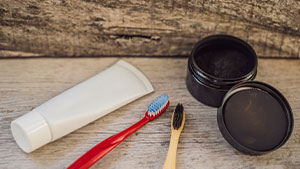

We may as well level with you right away. For the consumer, it’s very difficult (not to say impossible) to find out everything about a product when purchasing it. Because the life cycle, which is needed to assess impact on the environment, must be complete. This cycle must take into account everything related to production, from energy to the resources needed for raw materials to those used in the manufacturing processes and then goods transport, etc.. But most of the time, it’s difficult to access this information.
To form an opinion, consumers themselves assess the company’s reliability and its “clean” commitments, the ingredients and information about the manufacturing site. However, the material is already a very good indicator when it comes to beauty or hygiene accessories, like toothbrushes made of wood as opposed to plastic.
Blenders and silisponges – the new foundation sponges
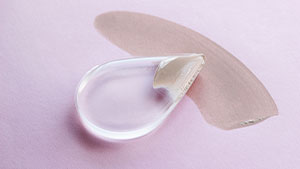
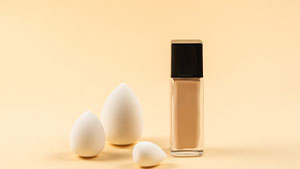
It has been the trend for a few years now. Blenders are those little egg-shaped sponges that have taken the place of the fingertips and brushes for applying foundation. You’ll now find them at all prices and in all sizes. Then there are transparent silicone sponges, which look like mini breast implants. We could condemn them because they are totally mass produced, artificial, non-recyclable and something of a gimmick. And that’s where the problem lies: if beautistas were to buy only one, and use it every day for years on end, this beauty tool would be of benefit. But generally, users have several and quickly drop them in favour of something new. Worse still, blenders need to be washed, which adds water usage and detergent to their impact. As for silicone sponges, they have a very short lifespan. How about going back to applying make-up with your fingers ?
Re-useable fabric cleansing wipes
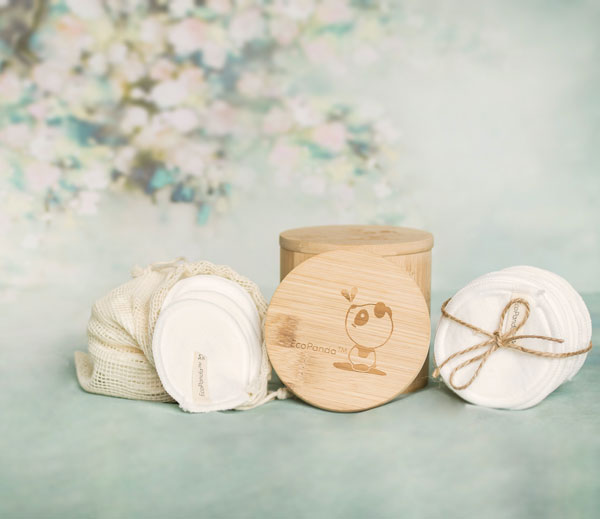
On the face of it, a square of (possibly organic) cotton towelling is bound to be more eco-friendly than disposable cotton cleansing pads. But… Some of these wipes are not made from cotton, but synthetic fabric. It’s the case of the big flexible cleansing wipes which are velvety-soft, machine washable, and claim to remove all traces without any cleansing product. These wipes are 100% polyester (synthetic plastic microfibre fabric). So they are polluting in terms of production and each time they are laundered, as they shed fibres into the water, and are non-recyclable. Otherwise there are double-sided washable cotton squares which can also be used to cleanse babies’ bottoms. Compared to disposable wipes these fabric squares are more sustainable, but unlike synthetic wipes that are used on their own, they need cleansing products to remove make-up. And the cotton used to make these squares still has to be from a responsible supply chain, since cotton cultivation requires a lot of water and takes place mainly in foreign countries. So it’s best to favour products made in the country where the product will be sold (in our case France) even if the raw materials may have come from the other side of the world. Cotton squares are the best option, when well looked after and re-used for several years with “clean” soap. And towards the ends of their lives, they can be used for cleaning windows !
Facial cleansing brush

These brushes, which generally have a plastic handle and bristles, are not enough by themselves. They have to be used with a cleanser. So compared to cleansing without a brush, with an identical cleanser, this item can’t compete with a hand or flannel when it comes to ecology and the environmental footprint. OK, it’s a sustainable tool since it lasts, but cleansing brushes get thrown away and not recycled. So that’s more plastic, more manufacturing in a foreign country, more goods transport and therefore more pollution, all of which is avoidable. The same goes for the electric variety, which are less gimmicky, more expensive and require even more material, but will be held onto for longer.
So what’s the most eco-friendly facial cleansing tool? It’s the konjac sponge, a hard little ball of 100% plant-based fibres, which once dampened turns into a flexible sponge and cleanses the skin efficiently. It can be used with or without cleanser, is biodegradable and inexpensive.
Anti-cellulite body brushes
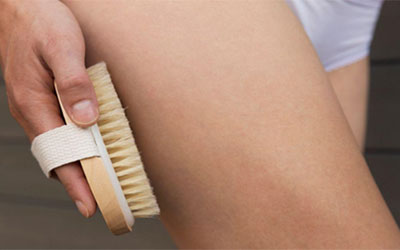
The comeback of “traditional” beauty tools is behind the popularity of skin brushing, (generally) with a wooden-handled brush with natural bristles. This dry brushing exfoliates the skin. It softens the epidermis, stimulates blood circulation and lymph flow to drain the tissues, avoid water retention for more toned skin, with reduction of the “orange peel” look. This routine, which requires neither products nor water, has no impact on the environment. It’s virtuous in terms of materials as well, since the body brush is generally plastic free, with boar bristles or similar and a fabric hand strap. The brushes are very sustainable, made in Europe or France. On the face of it, they have everything going for them. As for the massage variety with spikes, and massage gloves, go for those made of natural materials like wood or plant-based fibre, and from sites selling eco-friendly products rather than plastic ones.
Massage stones: gua sha stones and jade rollers
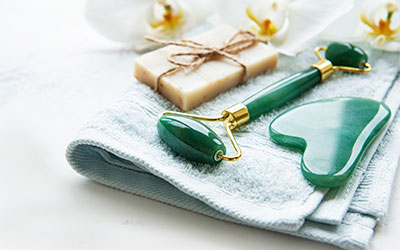
These two types of tool massage the face to stimulate microcirculation, drain the tissues and firm up the skin through a combination of movement and the stones’ properties. Jade rollers have a handle and a rotating polished stone at each end, which you roll across your face. A gua sha is a simple polished stone (quartz, amethyst or similar) without a handle. Flat and kidney-shaped or heart-shaped, it makes it possible – like a spatula – to smooth out the skin and shape its contours like a mini ‘palper-rouler’ treatment. Sure, these tools last a very long time, but does that make them eco-friendly?
Jade rollers and gua sha stones bring precious anti-ageing benefits and restore glow to the skin, which accounts for their success. They beg a question: How are they made? Because as with any “on-trend” product, increasing sales push companies to offer ever lower prices by cutting corners in manufacturing processes.
Jade rollers… Which are not made of jade!
Pure jade, which is an expensive semi-precious stone, is not the kind used in these rollers, despite their misleading name which would warrant some regulation. These rollers are made of various materials which can range from plastic to glass by way of aventurine and serpentine. This green stone requires chemical processing (which is not at all clean) to look like jade. Not only is it misleading, but these “jade rollers” made from chemically-processed stones are disrespectful of the planet. A real pure jade roller costs a minimum of several hundred euros.
Gua sha stones and eco-friendly rollers: choosing the right stone
Fortunately, most brands that offer up quality jade rollers and gua sha stones make them out of various types of stone to stay true to the spirit of these tools. It’s about making the most of the stones’ beneficial effects on the skin. You’ll find rollers and gua sha stones made of quartz, amethyst and also aventurine, and the attractive black stone that is obsidian.
To avoid being ripped off, you have to seek out natural stones that are just polished and information on how they are sourced. Because it’s not just chemical processes that can make these accessories catastrophic for the environment. The extraction method of these stones can drift out of line, given the increase in production to meet demand.
Brands rarely provide all the necessary information. There would have to be checks as to whether the stones come from an ethically-sound, sustainable seam. The first clue is, of course, the price. A gua sha stone or jade roller that’s sold for small change cannot be one made via an eco-friendly process. You can also buy a stone in a specialised shop, which can provide sourcing information, and massage your face with it.
Sustainable cotton buds
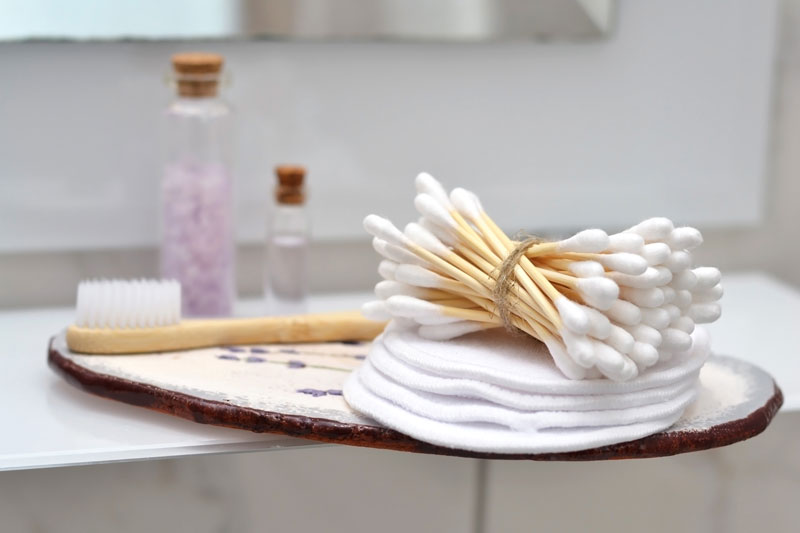
Plastic-stemmed cotton buds constitute one of the most widespread types of rubbish found in the sea. A ban that took effect in early 2020 granted a 6-month grace period to use up stocks of plastic-stemmed cottons buds and phase them out. Supporters of zero waste and zero plastic switched them out long ago in favour of oriculis, those flat bamboo sticks used to scrape out earwax. Ear cleaners like these can also be made from stainless steel, with a stem and a tip that looks like a tiny spoon, or with a spiral tip to clean the ear canal. These extremely sustainable tools are more eco-friendly than a lifetime’s worth of cotton buds.
But now, here come two new kinds of cotton bud which are considered eco-friendly: those with carboard stems and the washable silicone versions. So are they eco-friendly? Well, it’s not easy to run an analysis of their life cycle. These paper, cardboard or bamboo-stemmed cotton buds are biodegradable, can be thrown away and even composted. But they use cotton, the cultivation of which requires a lot of water and the processing of which is not always eco-friendly. As for washable silicone cotton buds, they don’t use cotton, but are made using a chemical process and also sold in plastic boxes. Even for an item that’s washable and sustainable, would it not be better to do without plastic? Again, favour principled brands and seek out the country of manufacture information to buy as locally as possible.
Menstrual cups: the plastic exception

The material used remains the top criterion, with wood and natural fibres generally being more virtuous than any kind of plastic. But in the bathroom, the menstrual cup is the exception. Its lifespan can exceed 10 years. It’s really worthwhile, from an ecological as well as financial point of view. In the space of a few months, you save on the dozens of sanitary towels and tampons that you would have bought and thrown away.
New-generation beauty tools and accessories are either poor quality and not very eco-friendly, made far away and without regard for the planet, or conversely, environmentally responsible. The latter being made from virtuous materials via a “clean” process.
When it comes to making a choice here, price is a good indicator. If costly, it’s an investment in a luxury product that really will last. Because switching out a disposable product and its packaging in favour of another item is really only beneficial from an ecological point de view if you’ll hold onto the latter for a long time.


